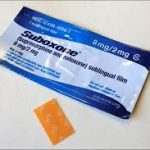How Can You Get Off Opioids with Another Opioid Medication?
Addiction to prescription opioid medication is at epidemic levels. Entire communities are devastated by the effects of this increasingly widespread addiction. Recent statistics even show that there are more people who are using prescription opioids than tobacco. Suboxone has emerged as a possible treatment method for opioid addicts.
But because suboxone is a form of prescription opioids, some may wonder if it’s just trading one addiction for another. Here’s what you need to know about why and how suboxone works.
What is Suboxone?

Suboxone reduces withdrawal symptoms and has a low abuse potential.
Suboxone is the name of a drug that contains the medications buprenorphine and naloxone. Buprenorphine is a synthetic pain opioid and naloxone is a drug that prevents overdose. According to SAMHSA, suboxone is a form of medication-assisted treatment (MAT) that can be a part of helping people beat addiction to opioids. Inpatient suboxone detox may use a combination of suboxone, counseling and social support.
Why is Suboxone Less Addictive than Regular Opioids?
Many people may wonder about how it’s possible to beat addiction to opioids by taking another form of opioid medication. Although the buprenorphine component of suboxone is an opioid, it’s technically an opioid partial agonist. That means the drug’s effects have a “ceiling,” a limit after which it isn’t possible to get more of a high or euphoric feeling.
The naloxone component of suboxone is the drug that first responders give to people in the midst of a drug overdose to reverse the effects. This has a moderating effect on the opioid. Together it means that suboxone has a weaker effect than other opioids and even methadone. It is possible to abuse suboxone, but it is difficult.
What are the Side Effects of Suboxone?
Although suboxone is safer than other prescription opioid medications or heroin, that doesn’t mean that it’s completely harmless or free of side effects. Some of the most common side effects of naloxone come from the buprenorphine component of the drug. They include the following possible side effects:
- Nausea and vomiting
- Constipation
- Irritability and distress
- Fever
- Muscle aches and cramps
- Drug cravings
How is Suboxone Used in Treatment?
Suboxone can be a key component of treatment in inpatient suboxone detox programs. Unlike methadone, which can only be administered in specialized clinics, suboxone can be prescribed by a wider range of providers. It is especially useful in helping opioid or heroin addicts to detox from active use. According to SAMHSA, this usually occurs in one of three stages:
- The induction phase, which takes place within 12 to 24 hours of the last opioid dose. It’s important to note that suboxone can cause acute withdrawal symptoms in people who have other opioids still in their system.
- The stabilization phase, which begins after the individual has stopped their use of opioids. At this point of treatment, the dose of suboxone can often be changed to a lower one. Some people can even skip a day between doses.
- The maintenance phase, which can last for a very long time in recovery. Some people stay in this phase for an indefinite period of time, while others may eventually work toward stepping off of the medication entirely. As with all use of suboxone, this decision is best made between the patient and his or her doctor.
Inpatient suboxone programs will ideally help the addict move through these three stages of treatment. The induction phase usually occurs shortly after being admitted to a treatment program and includes the detox period. During the stabilization phase, patients are also working on therapy and recovering from active addiction. The maintenance phase prepares the addict to re-enter society and manage their cravings in the future. Many people will want to be part of a support group such as Narcotics Anonymous after leaving rehab.
If you have questions about how suboxone can help someone you love to quit abusing opioids, call our helpline today at 888-646-0865 (Who Answers?) .





